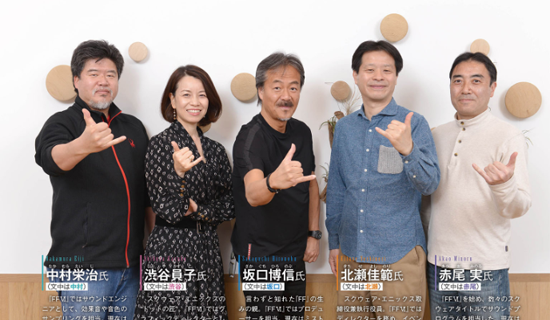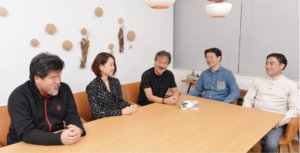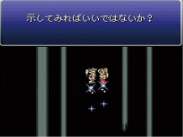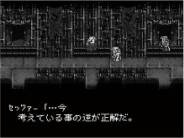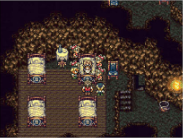25 years ago, Final Fantasy was already a hugely popular series. But with FFVI you can really feel the determination of the staff to not rest on their laurels due to the series’ reputation. These legendary creators took a look back at their memories of the development of this title with us.
Eiji Nakamura – As the sound engineer for FFVI, he was responsible for the sound effects and sampling. He’s currently the president of Sound Racer.
Kasuko Shibuya – Square Enix’s “Pixel Artisan”. As the graphics director for FFVI, she was in charge of the character pixel graphics.
Hironobu Sakaguchi – As the father of Final Fantasy, he needs no introduction, and he served as the producer of FFVI. He’s currently the president of Mistwalker.
Yoshinori Kitase – An executive officer at Square Enix, he served as the director for FFVI. He also put together the event team.
Minoru Akao – He was in charge of the sound programming for many Square titles, beginning with FFVI. He’s currently the president of RedSpark.
A Staff Of 30 People Came Together To Create FFVI
First of all, I’d like ask about the atmosphere amidst the development team. Were there FF series veterans like Mr. Sakaguchi and Ms. Shibuya, as well as first timers?
(Nakamura) I’d just started at Square then, and I was really scared of Mr. Sakaguchi (Laughs)
(Sakaguchi) Huh, really? Did I get angry with you or something?
(Nakamura) When we first met, the very first thing you said to me was “Don’t bring the quality down” with a very serious look on your face…
(Sakaguchi) I don’t remember that (Laughs)
I…can feel the pressure from that myself!
(Nakamura) I didn’t even really know how to use the computers. You had to type in commands to operate them, instead of using a mouse or whatever. So I started from a position of not knowing what was what, and I learned a lot from Mr. Akao as I worked on the game.
(Akao) It’s no wonder that Nakamura was all depressed when we went out to drink after that, saying “Mr. Sakaguchi said I can’t bring the quality down…” (Laughs)
Mr. Sakaguchi’s words really stuck with you, didn’t they Mr. Nakamura? (Laughs) Is there anything that you remember particularly well from the development of FFVI, Mr. Akao?
(Akao) From the Famicom era before FFVI, Konami’s games always had the coolest sound. That’s why Mr. Sakaguchi told me to “Beat Konami” (Laughs)
(Sakaguchi) He went and said it (Laughs) Akao is a really amazing guy who used all possible means to reproduce Mr. Uematsu’s sound in-game.
(Nakamura) We’d get requests from Mr. Uematsu like “When it goes from the map into a battle, I want the music to pick up where it left off when it goes back to the map” and “I want you to put some vibrato in the music”. And Mr. Akao made all of those requests happen.
(Akao) It was very tough keeping resource usage down for the sound as I experimented to see how I could implement Mr. Uematu’s requests.
Truly a job that only a sound programmer can do.
(Akao) I think there’s an image of sound programmers being good at composition, but they’re actually just regular programmers. They’re in charge of the sound related aspects of the game, and we don’t go around pretending to be composers. FFVI was released on the Super Famicom, but one unique trait of that platform is that it had 2 CPUs. My attention was focused on how I could properly utilize those CPUs for separating the sound from the rest of the game.
(Sakaguchi) I just now thought about it, but was there anyone specifically in charge of the sound effects in FF games up until that point?
(Akao) There wasn’t. When someone working on graphics would finish up their tasks, you’d just say “Alright, now program the sound effects”.
(Sakaguchi) Oh yeah, that’s right! We’d give the tools to whoever was free, and explain how to use them. And while they were trying to figure things out you’d just hear all these screeching sounds.
Huh!? You’re saying that all the way through FFV, staff members who worked on graphics were responsible for the sound effects?
(Shibuya) I didn’t ever work on them, but I believe quite a few of the staff members who worked on graphics did.
(Akao) They created the sound effects for the roaring of the flying dragons, for example. FFVI was the first time we had any staff specifically on sound effects.
I see. Approximately how large was the development team for FFVI?
(Shibuya) It was about 30 people.
(Kitase) Looking at it today, 30 people seems like an incredibly small development team. But back that, a 30 person development team was quite big.
(Sakaguchi) That’s true. For other game genres, the teams would often be 4-5 people.
(Kitase) Mr. Sakaguchi and I did all of the event planning in FFV. But for FFVI there were 5 people doing it, including Mr. Sakaguchi. It definitely felt like there were more of us working on that project at the time.
The Young Staff That Worked On This Title Are Now Legendary Creators
When I look at the staff credits for FFVI, there are so many names that are now at the front lines of the industry. It really was a legendary team.
(Sakaguchi) Oh come on, everyone was just using FFVI to get a promotion, right?
(Shibuya) That definitely could have been the case (Laughs)
(Sakaguchi) I’m half-joking about that, but we really had nothing but great staff members on that project, particularly when it came to graphics. There was Tetsu (Tetsuya Nomura), Taka (Tetsuya Takahashi, now president of Monolith Soft), Naora (Yuusuke Naora, now with IZM designworks), and Minaba (Hideo Minaba, now with CyDesignation). From FFIV to FFV the games really started selling, so they really took on the feeling of being major titles. I don’t believe they were cutting edge titles up through FFIII. I said this previously during a live stream, but I even really thought the last dungeon of FFIII was horrible (Laughs bitterly) But we achieved sales in the millions for the first time with FFIII, so we got a lot of new people on staff as a result of that. That “Second Generation of FF” coming in was quite a big deal.
Mr. Kitase, do you have any memories of the young staff members that joined around the time of FFVI?
(Kitase) Not really, I was a young staff member at that point too (Laughs) Mr. Sakaguchi was the one who primarily put the team together. I was kind of in charge of putting the event planning team together, but everyone came in around the same time so there was no real pecking order. I remember us just all excitedly working on the game.
(Sakaguchi) Kitase sat close to the programmers, and had conversations with them. So he was in charge of things like conserving memory to fit in a new map, creating the paths to advance cut-scenes, and just the inner-workings of a lot of the cut-scenes in general. So he took charge of cut-scenes that I didn’t even know anything about (Laughs) For example, the scene where they’re going down the stairs at Darill’s Tomb, the scene between Maduin and Madeline, that kind of thing. My reactions were basically “I didn’t know about this, but wow!” (Laughs)
(Kitase) Things didn’t look particularly realistic in the Super Famicom era, so we were able to express things in all sorts of different ways. The Maduin and Madeline scene had a very short plot line in the scenario. But we got across the emotion that Mr. Sakaguchi wanted to convey, and really put everything we had into creating the cut-scenes.
(Sakaguchi) That plot point was about 4 lines of dialogue. And I wondered if Kitase was going to challenge me on the “How can we know for sure unless we try for ourselves?” line or not (Laughs)
The World Of Ruin Wasn’t Originally Planned!
FFVI didn’t follow in the footsteps of FFV in terms of having its popular job system, but instead steered in a direction of having a story more based around its characters. What were you aiming for with that?
(Sakaguchi) People say that the odd numbered FF games are system-based and the even numbered ones are story-based, but it’s just not determined in that way. It’s simply a matter of the creators getting tired and not wanting to do things the same way as the last time, so they’re just changing the way it’s presented.
Why did you choose to use a world where technology and fantasy are so intermingled together?
(Sakaguchi) We weren’t particularly immersed in typical fantasy about swords and sorcery in the first place. So we thought it would be alright to have a fantasy world where technology existed. We were able to express things in various ways due to the evolution of hardware and development techniques, and we’d gotten more used to game creation as well. And I feel like Taka (Tetsuya Takahashi) being a big mech enthusiast had something to do with it too (Laughs)
It was a shocking development when the world was destroyed, and you continued traveling through the World of Ruin afterward.
(Sakaguchi) Actually we didn’t initially plan to make the World of Ruin at all.
(Kitase) We originally planned for the party to save the world and defeat Kefka just as things were looking grim and the world was about to be destroyed. Then we started talking about reworking that.
(Sakaguchi) The game was coming along more smoothly than we expected, so we were able to free up some time in our schedule before the release date and implement that.
Speaking of the World Of Ruin, you really livened up the scene with Celes and Cid on Solitary Island during a recent live stream (a series of streams in which Sakaguchi plays FFVI on Famitsu’s YouTube channel).
(Sakaguchi) That’s right, I kept feeding Cid fish (Laughs) Kitase, you were the one who made that part, right?
(Kitase) I was. It was purposefully made difficult by giving no hints as to which fish you give him. I created it with the route where Cid dies being the original one. But I thought it would be better to have a way of saving him, so as a bit of an extra I made a way for Cid to not die if you tried hard in giving him fish.
(Nakamura) I’d like to ask Mr. Kitase something: Why did you put that bird on that beach!? It gets in the way too much and makes it hard to catch fish! (Laughs)
(Kitase) If you look closely, you’ll understand. That bird is there in the scene when Celes throws herself off the cliff as well, connecting things to the previous events on the beach. That bird is what gives Celes her change of heart.
(Sakaguchi) I see. But it does get in the way (Laughs)
(Kitase) I’m sorry about that (Laughs)
(Shibuya) The Celes throwing herself off the cliff scene was a good example, but I was very surprised by the unexpected ways in which the character graphics were used. I drew them in all sorts of different animations, like waving and fainting. Since the characters in FFVI had the same proportions on both the world map and in battle, you could use those animations in any scene. So when I saw the completed cut-scenes, I was surprised at the use of the character graphics in ways that I didn’t think of them to be used in.
The graphic of Celes taking damage was used in the scene where she throws herself off the cliff, for example.
(Kitase) It’s true that we were able to take the graphics that Ms. Shibuya drew and use them as characters to act out events in the cut-scenes.
Incidentally, there are differences in the details between the character drawings that Yoshitaka Amano did for FFVI and the ones appearing in the game, but why is that?
(Sakaguchi) That’s because Mr. Amano was working on those at the same time we were working on the game.
(Shibuya) Even now I still often get asked “Is Terra’s hair blond or green?”. If we’d gone by Mr. Amano’s designs, just about all of the characters would have blond hair, and it would be harder to distinguish between them. And having them all be blond would dilute their distinctive traits as well. So I had control over the character colors on-screen while Mr. Amano was free to draw them however he liked.
Also, did Amano’s illustrations or Ms. Shibuya’s pixel art come first?
(Sakaguchi) Shibuya’s came first in just about every case.
For the designs, did you sketch them out first and then convert them into pixel graphics?
(Shibuya) No, I drew them as pixel graphics from the start. Drawing them on paper first was a waste of time, after all. And since at that time the project wouldn’t progress unless I was able to create the graphics gradually, getting something done with a small victory (Laughs) For example, I initially designed Terra with short hair, and quickly handed the data over to the programmers. And as she was actually implemented, I gradually brought her closer to the Terra that everyone knows now.
Feelings Of Rivalry With Dragon Quest Allowed FF To Grow Into An Epic
FFVI went on sale on 04/02/1994 in Japan, so if you calculate things in reverse, development finished 1-2 months earlier that same year. How long did it take from the start of development to completion of the master build?
(Sakaguchi) Right around 1 year.
(Shibuya) Development started right after work on FFV finished, so it may not have even taken a full year.
I assume that approximately 1 year was very grueling?
(Nakamura) I was a new employee, so I was extremely busy. It was so hectic that I remember barely any of the details. For example, it was necessary for me to see the actual game in order to see what weapon a character was attacking with when making sound effects. So I’d make the sound effects as I was playing and debugging…that kind of thing. It was a common thing for us to sleep in the office.
(Sakaguchi) I slept in a chair that folded out into a bed (Laughs)
(Kitase) I brought a sleeping bag in with me.
(Akao) I had a down futon!
(Everyone) A down futon!?
(Akao) Yeah, a small one that I spread out on the floor (Laughs)
These are memories that only could have come from back then (Laughs) But even though you were sleeping in the office overnight, you still had the energy to make something of high quality.
(Sakaguchi) That’s because Dragon Quest was such a big motivator. It has such a unique atmosphere, and wonderful scenario writing by Yuji Horii. We wanted to make something top-notch because we were determined to surpass Dragon Quest.
(Kitase) Mr. Sakaguchi, during FFV you even said “We’re going to surpass Dragon Quest in number of games!”
(Sakaguchi) Back then I didn’t think we’d win in terms of games (Laughs) From the first game in the series I only felt that we’d never lose out in terms of graphics. Of course we always put effort into the systems and scenarios, but that was the only aspect in which I had confidence that we’d beat out Dragon Quest in. Ah, speaking of Dragon Quest, there was that one event that you rejected.
(Kitase) Huh, which one was that?
(Sakaguchi) So in the FF series, no matter how many members you have in your party, only one of them will be shown moving around on the map. You could think of it as something like the party combining into one character to represent everyone. So in the event that you rejected, the four party members tried to combine into one, and said “Huh? We can’t combine!?”. So the four of them were shown all lined up behind one another, very reminiscent of Dragon Quest (Laughs)
(Kitase) Ahh, I believe I rejected that one saying “This is too joke-y!” (Laughs)
(Laughs) Now for our final question. Is there anything that you’ve realized all over again from playing FFVI from the beginning, as a part of the live streams?
(Sakaguchi) It may seem like I’m singing my own praises, but FFVI is really still fun to play now, even though it’s an older game. Games went to 3D and grew much bigger in scope after this, but that’s another matter, and I feel this is a game that you can still have a lot of fun with today. Also the bird on the beach gets in the way after all (Laughs)
(Kitase) I’m so sorry (Laughs)
Cut-Scene Pickup #1
How Can We Know For Sure…
Mr. Kitase was in charge of the emotional scene where Maduin says “How can we know for sure unless we try for ourselves?” to Madeline, who is unsure whether or not humans and espers can be together. The two dance together, and then Terra is born.
Cut-Scene Pickup #2
And That’s A Big Mistake
Setzer quotes Darill during the ending, but what’s the meaning behind what he says? People have been guessing at it for many years now. But Mr. Kitase, who was in charge of this scene, says “It doesn’t mean anything in particular (Laughs) So it doesn’t really matter either way”.
Cut-Scene Pickup #3
Hang In There Katarin…
Mr. Sakaguchi had high hopes for the scene where Katarin was giving birth. And as it happens, Mr. Sakaguchi had just had a child himself. He said “There’s nothing so emotionally moving in life” and “She definitely has her child in the ending”.
Favorite Characters And Scenes
 Hironobu Sakaguchi
Hironobu Sakaguchi
Character: Everyone
Scene: Phantom Train, etc.
I can’t choose a single favorite character. For scenes, of course I love the opera, but from an artistic standpoint it would be the phantom train. I think Hideo Minaba (Art Director) really gave it his all. And I really love the opening…I guess I love all of the scenes (Laughs)
 Yoshinori Kitase
Yoshinori Kitase
Character: Celes
Scene: Opera
After creating the World of Ruin, which we hadn’t originally planned to do, I had a strong emotional attachment to Celes ever since I started event planning for the second chapter where we tried to make her the main character. And of course the scene that sticks with me the most is the opera.
 Kazuko Shibuya
Kazuko Shibuya
Character: Kefka
Scene: Darill’s Tomb
Kefka is a very distinctive character in the FF series. I was able to express his insanity through animations very well. My favorite scene is Darill’s Tomb, it honestly moved me.
 Minoru Akao
Minoru Akao
Character: Sabin
Scene: Opera
I think my favorite character is Sabin. And my favorite scene is of course, the opera. In trying to figure out how to express this in terms of sound, Mr. Uematsu said “I want to do something different than usual”. And so I figured it out through much trial and error.
 Eiji Nakamura
Eiji Nakamura
Character: Shadow
Scene: Ending
My favorite character is Shadow. I really love the back and forth between Shadow and Interceptor during the ending. It’s a bit of a sad scene, but it really left and impression on me.
